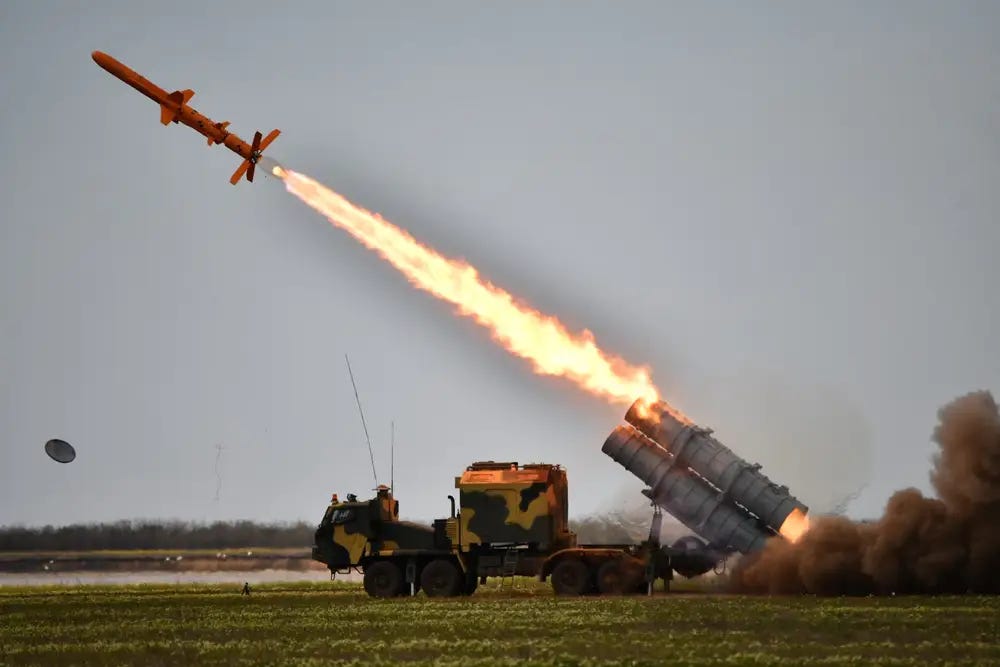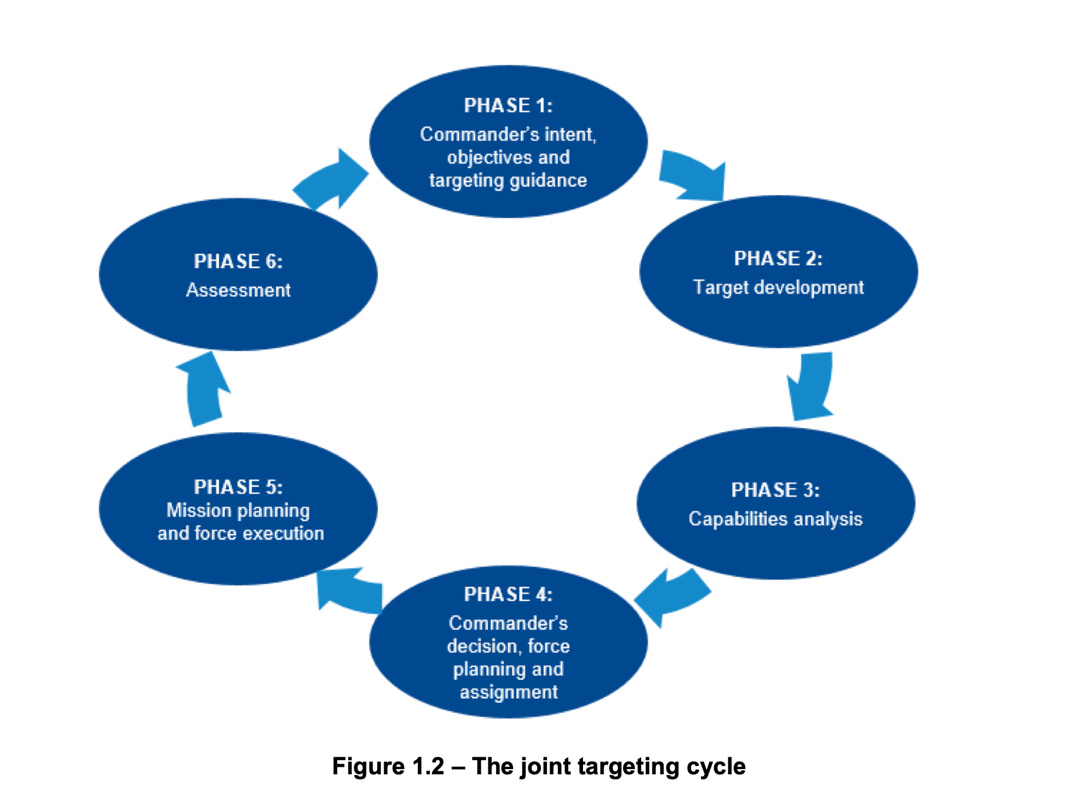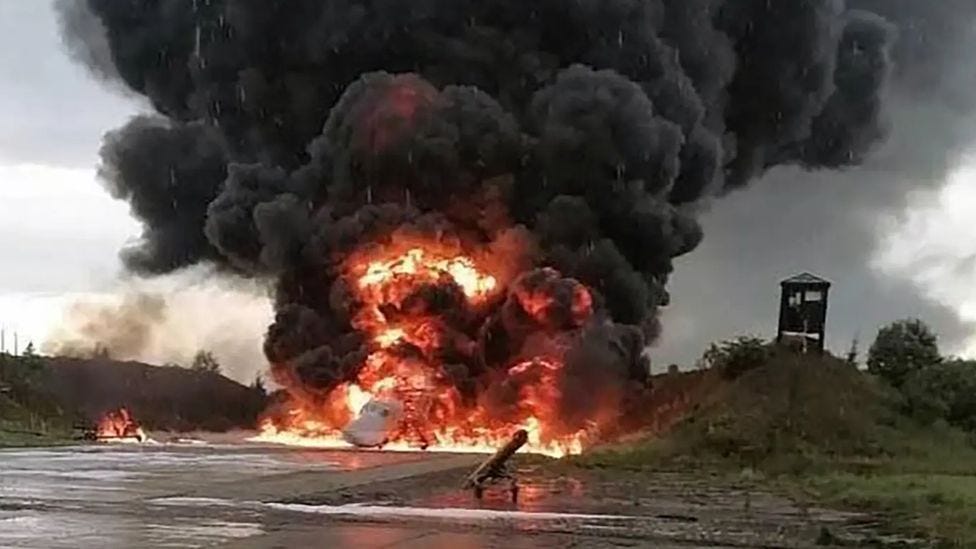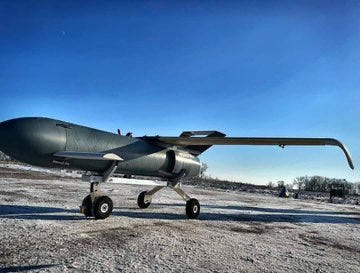MICK RYAN

Today’s strikes against a Russian oil terminal in Bryansk, as well as in the Leningrad region, represents the continued maturing of Ukraine’s strategic strike campaign against Russia. These are the second and third such strikes in the past 48 hours, with another attack against a major Russian oil loading terminal in St Petersburg, on Thursday. As I explored in my first article on this topic nearly a year ago, long range strike has been an important strategic adaptation for the Ukrainians since the beginning of the Russian large-scale invasion nearly two years ago.
In theory, strategic adaptation should increase the strategic effectiveness of the institution undertaking innovation and organisational change. This is the case with Ukraine and its evolving ability to hit Russian targets at greater distance and with increased frequency. Ukraine has demonstrated an ability to undertake a systemic program of indigenous research, development and production, absorption of Western weapons (such as Storm Shadow and SCALP) as well as the application of Western doctrine for joint strike planning and execution.
The Ukrainian strike complex appears to be maturing just as it is needed most.
This year, Ukraine is likely to assume a strategically defensive posture. This is to its advantage. As I outlined in a recent War Shorts Commentary, positional warfare is Ukraine’s friend in 2024. It allows Ukraine the time to reconstitute its army, through training, equipment replacement and standardisation, rest and rotation, as well as potentially mobilising new troops and formations. It also permits time for rebuilding of Western defence industry, and the conservation of resources this year so they can be built up and then expended in 2025 offensives.
Finally, embracing positional warfare provides the breathing space for a reconsideration of Ukrainian and Western strategy for the war. As I wrote in a recent Foreign Affairs article, Western strategy must shift from resourcing the ‘defence of Ukraine’ to resourcing the ’defeat of Russia’. Without such a change in strategy and resources, it is difficult to see a resolution to this war that is both just and enduring for the Ukrainian people.
This doesn’t propose however that Ukraine must be entirely passive throughout 2024. As such the strategic strikes in Russia, in Crimea, against Russian military operational infrastructure and maritime strikes in the Black Sea will be vital shaping activities in the coming year. In a later part of this article, the key functions of the Ukrainian strike complex in 2024 will be examined. However, to inform that exploration, what is the Ukrainian Strike Complex?
Components of Ukraine’s Strike Complex
Strike operations fit within a larger military approach to war fighting. Generally, they are understood to comprise deep operations as part of a deep-close-rear battlespace construct. Strike operations can employ forces in the physical domains, including missiles, drones, special forces and other assets. But they may also include cyber operations or influence operations by themselves or in concert with actions in the physical world to generate shock, surprise, influence and systemic effects.
Some of the key concepts associated with the development, employment and adaptation of a national military strike capability, which broadly align with the principles of war adopted by many nations, include the following:
- Selection and maintenance of the aim. This above all else is essential in strike operations. It ensures that the right targets are chosen for the right purpose, and guides prioritisation of resources, timing and the integration of strike with other military and national efforts.
- Concentration of effort. Ukraine has a finite arsenal of strike weapons. This is due to numbers supplied by Western nations, but also because of the need to balance investment in strike systems with investment in other military capabilities (such as air defence and ground combat forces). As such, the resources for strike operations are carefully husbanded and controlled at higher levels.
- Integration. Strike operations must have an impact beyond the physical destruction or virtual neutralisation of a target. There must be a systemic impact on the enemy. The deep-close-rear construct is an important guideline in the conduct of strike operations, but also in the institutional balancing of investment in systems for each. This was an important observation from my December trip to Israel: over investment in long range recon-strike can blind or degrade close combat capabilities. Finally, strike operations often require integrated planning with different elements of a military force, and often, with agencies beyond the military.
- Surprise. This is critical to strike operations. Surprising an enemy is one method of seizing the initiative and often comprises a crucial precondition for success. It is however transient and must be exploited rapidly.
- Sustainability. Strike operations must be able to be conducted over time. This infers a broad range of capabilities that can be used at the right time and place to generate the right effect. But it also means that weapons stocks must be sufficient and constantly replenished.
In a macro sense, Ukraine’s strike complex comprises the following five components:
Reconnaissance and surveillance. The finding and mensuration of targets is an important part of any strike system. You can’t strike what you can’t find. In many nations, this is often a very technical activity, enabled by satellite capabilities, advanced electronic warfare and cyber systems as well as many different types of military and commercial drones, and special operations activity. Ukraine has access to these kinds of capabilities from its allies and from its indigenous systems.
To this must be added Human Intelligence operations (HUMINT) – which is conducted by resistance personnel and Ukrainian special forces in Russian occupied territory - and most importantly, open-source intelligence (OSINT). As I have written here previously, the new era meshed civil-military sensor network provides a massive trove of targeting data for clever military institutions. And the Ukrainians have become adept at this.
Joint strike planning and coordination. This is an area where Ukraine has largely adopted NATO joint targeting doctrine. In my discussion with members of the General Staff in Kyiv in 2023, we discussed how this occurred and how it is progressing. Those I spoke with were generally happy with the implementation of this doctrine. This NATO doctrine notes that:
Joint targeting is fundamentally an integration function that requires participation from the strategic and operational levels, all joint force staff elements and component commands, along with various non-military organizations.
For a sense of what a targeting process looks like, below is a diagram of the joint targeting cycle from NATO doctrine (which is, amazingly, available freely online).
I
mage source: AJP-3.9 Allied Joint Doctrine for Joint Targetin
An integrated targeting process allows for better use of scarce resources, improved integration of strike operations with strategic and operational objectives, as well as the coordination of issues such as airspace deconfliction, deception and integration of all aspects of a national strike system. To do this, Ukraine has a joint targeting staff as part of the general staff of the Ukrainian Armed Forces.
Strike systems. This is the part that many focus on. Over the course of the war, Ukraine’s arsenal of strike weapons has continued to expand. From mid-2022, Ukraine has demonstrated the ability to absorb and use very precise, long range rocket systems against the Russians such as the HIMARS and MLRS systems.
The Ukrainians are believed to use the standard Guided Multiple Launch Rocket System (GMLRS) and has some ATACMs rounds as well. It also has reportedly just received HIMARS-launched Ground Launched Small Diameter Bomb (GLSDB). Other ground launched systems include the S-300, which has a ground attack mode, and the Neptune maritime strike missile (which is being upgraded to increase its range and penetration capability).
Ukraine has also been developing indigenous drones for longer range strikes. In January they announced the testing of a kamikaze strike drone with a range of 1,000 km. As an ISW update notes, “this long-range drone entered production with international partners (likely based in Europe), and Ukrainian officials claim that Ukraine will produce 1,000 such drones by the end of 2024.
Air launched systems also play an important role. The provision of the UK-built Storm Shadow missile was announced by Britain in May 2023. The Storm Shadow is a stealthy missile launched from fighter aircraft and able to hit targets over 250 kilometres from its launch point. The Storm Shadow is designed to strike high value targets with its 400-kilogram penetrating explosive warhead. The missile, and its French SCALP-E equivalent, extends the ability of the Ukrainian armed forces to strike Russian targets.
The Ukrainian maritime strike capability has developed quickly since February 2022. The Ukrainian Navy now has at least three uncrewed surface attack vessels, including one that is armed with rockets. The first is a five metre long, surface vessel that looks much like a covered speed boat. A second USV developed by Ukraine is a semi-submersible vessel, which is smaller than the larger surface USV used in the October Sevastopol attacks. Little is known about this vessel. A third vessel is the Toloka Armed Uncrewed Underwater Vehicle (UUV). Designed as a family of one-way kamikaze submersibles for attacking Russian warships, the Toloka’s have a range from 100 to almost 2000 kilometres depending on the variant. A great resource on this evolving Ukrainian capability is H.I. Sutton, “Ukraine’s Maritime Drones (USV): What You Need to Know”, published at the Covert Shores website here.
Deception and Survivability. In order to plan and conduct strike operations, Ukraine needs to protect that capability. As such, it has become adept at deception and camouflage operations to ensure that systems such as HIMARS and the locations of its strike aircraft and missiles are hidden as much as possible from Russian intelligence and strike targeteers.
Another element is not declaring when new capabilities are arriving or will be employed so as to surprise the Russians. The initial operations of HIMARS and ATACMs were very successful because of this, but the Russians soon adapted. That said, according to at least one report, the Russians are yet to destroy a single HIMARS launcher. But these are simpler to hide than aircraft and their supporting infrastructure. This ongoing effort to protect the Ukrainian strike complex, especially given its importance in 2024, will be a major concern for the Ukrainians this year.
Assessment systems. Finally, the Ukrainians undertake post-strike assessments. This is designed to ascertain whether the strike achieved its objectives, and if it didn’t, what were the Russian methods that either defeated the strike system enroute or at the target itself. This is an important part of strategic learning and adapting Ukraine’s strike complex. While there are a range of classified systems that are used in this process, open-source information is also vital.
In this environment, how does Ukraine’s strike complex contribute to the war?
Employment of Ukraine’s Strike Complex in 2024
There are several key functions that Ukraine’s evolving strike complex will support an evolved and more defensive military strategy for Ukraine this year.
The first function is to support the achievement of Ukrainian operational and tactical activities. An example of this might be the recent downing of the Russian air force A-50 Mainstay command and control aircraft this month. It was providing sensor coverage of Crimea and southern Ukraine, which potentially degraded Ukrainian strikes in those locations. Its downing increased the effectiveness of the Ukrainian strike system in that area. Other examples of this would be attacking key Russian headquarters, transport routes and logistics nodes in occupied Ukraine.
Airfields have increasingly been targeted by the Ukrainians. While this campaign against Russian airfields began in 2022, it has broadened over time. One of the most spectacular was the attack on 22 August 2023 which resulted in the destruction of a Tu-22M strategic bomber at Russia’s Soltsy-2 airbase. Australian-made cardboard drones were used to attack an airfield in Kursk, and an attack was conducted on Russian helicopter bases at Berdyansk and Luhansk, destroying or badly damaging two dozen helicopters. Tatarigami provides a good assessment of these attacks. These airfield attacks not only destroy capability, but the attacks also force a Russian reassessment of their air defence resources as well as having to redeploy these assets further from where they are most needed.
The Kerch Bridge has also suffered multiple attacks. it is a legitimate military target because of amount of military traffic that uses it to resupply Russian occupation forces in Crimea. It is also a political target because it was project personally overseen (and opened) by Putin. You can read more about the Kerch Bridge attacks here.
Overall, Ukrainian strikes have resulted in the destruction of some Russian logistics, headquarters and reserves but have not paralysed Russian operational support or their overall command and control. Whether this is because of Russian resilience ,or because integration between strike and ground maneuver is insufficient, remains to be seen. However, it is likely that more effort will need to be allocated to operational strike in 2024 to attrit key Russian enablers and to degrade Russia’s capacity to undertake coordinated offensives.
A second function of the Ukrainian strike system is to enhance Ukraine’s strategic freedom of maneuver. This freedom of maneuver is not exclusively military. A good example of this is the attacks on the Black Sea Fleet. This has led to the Russian fleet being less effective in the western reaches of the Black Sea. Consequently, it has permitted the Ukrainians to reopen a maritime trade corridor which is essential to their grain export operations – and earning foreign currency.
A third function is to engage in economic warfare and to degrade Russian industrial capacity. As the allies found during the Second World War, destroying an enemy industrial system using strike operations is very difficult. There have been two recorded strikes on the Mashinostroeniya Design Bureau in Kolomna, which develops missiles and anti-tank guided missiles. Ukraine is also reported to have recently attacked gun powder factories in Bryansk and Tambov and other locations.
However, Ukraine will not be able to entirely destroy Russia’s mobilized defence industrial capacity. It can however degrade it in concert with international sanctions, slow down weapon deliveries, or make it difficult for workers (or foreign advisors) to want to work in this industry. Often, destroying the power source for an area can have an equal, or even larger, impact than physically destroying a factory that makes defence material.
Recent strikes against Russian oil storage and export facilities, pipelines and ships indicates that Ukraine is also implementing an economic warfare strategy. Russian oil and gas export income declined in 2023. Ukraine may aim to further decrease this source of revenue in 2024 because of how important it is to the Russian federal budget. It may also have an impact on fuel supply for Russian forces.
As such, Russian energy production and export infrastructure is likely to be a key target in 2024. This has a secondary impact of responding directly to Russian attacks on Ukrainian power generation capacity and oil storage facilities.
Finally, the Ukrainian strikes have important political purposes. The 2023 strikes on Moscow using drones, the Kerch bridge, airfields and even railway tracks within Russia were calculated to paint a picture of Russian military and political incompetence for the Russia people. This is intended to keep political pressure on Putin and demonstrate to Russian citizens that the war is not going their way. It is not clear that this is having a major effect (yet). The other political purpose, which will be vital in 2024, is to demonstrate to Ukraine’s western supporters that it is still in the fight.
The key point with this last function however is to get the balance right between strikes with political purpose and those that are designed to attrit Russian forces and degrade their offensive capacity in 2024. That is a very difficult balancing act. But Ukraine can’t afford too many ‘spectaculars’ if it degrades their ability to hurt Russia’s offensive capability this year.
Strike Complex Challenges for 2024
Despite the utility and increasing capability of their strike complex, the Ukrainians will have several challenges with it in the coming year.
First, Ukrainians need to build and sustain their magazine depth for their missile and drones. This is a profound industrial challenge, which Western nations are still struggling to address. If a US assistance package is not forthcoming soon, this challenge will only get more difficult. While indigenous production of lethal drones and missiles in Ukraine will fill some of the gap, Western weapons and intelligence remains crucial to Ukraine strike complex in 2024 and beyond.
Second, the Ukrainians will need to constantly adapt the conduct of their strike operations. The Russians have developed an effective approach to strategic adaptation, which is producing electronic warfare and other systems which attempt to degrade the Ukrainian strike complex capability. The Ukrainians will need to continue evolving the systems to be hardened against Russian counters, continue their operational security and deception operations, and potentially broaden the type of attack systems they possess in order to keep the Russians off balance.
Third, strike will need to balance the building of a foundation for 2025 offensive operations with achieving 2024 strategic influence activities for Ukraine’s political leaders. This returns us to the ‘deep-close-rear’ construct but also includes a temporal aspect. There will be a temptation among some to generate spectacular strikes in the short term to generate attention. This will be necessary at times, but getting attention from Ukraine’s supporters will require other methods as well. A more compelling priority for Ukraine’s strike complex in 2024 may be the activities to degrade Russia’s ability to command, move, maneuver and support forces preparing for, or engaged in, offensive operations.
And finally, strategic strike does not win wars by itself. It is a decisive capability for a nation’s warfighting efforts, but only if it is integrated with the array of support, command and close combat activities that are required to destroy the Russian forces, seize territory and sustain the support of international partners.
In conclusion, Ukraine’s maturing strike complex is an extraordinarily impressive achievement and will have a vital role to play in Ukraine’s 2024 military strategy. It will provide some breathing space for the Ukrainian Armed Forces, will help attrit the Russian forces and assist in Ukraine achieving some of its strategic influence objectives.



No comments:
Post a Comment